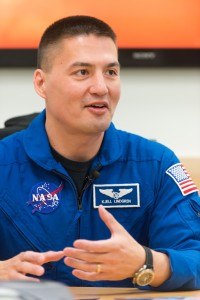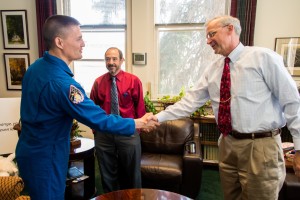Update: Colorado State University alum Kjell Lindgren, one of a three-person crew on a Soyuz rocket bound for the International Space Station, successfully launched at 3:02 p.m. MDT from Kazakhstan. The astronauts joined their Expedition 44 crewmates on the space station at 10:56 p.m. MDT July 22.

Starting this week, a space doctor educated in Colorado has the sky-high responsibility of managing scientific experiments aboard the International Space Station that will help determine whether astronauts are physically fit for travel to Mars.
Kjell Lindgren earned a bachelor’s degree in biology from the U.S. Air Force Academy and a master’s degree in cardiovascular physiology from Colorado State University; he also attended medical school at the University of Colorado. On Wednesday, Lindgren, a specialist in aerospace medicine, will become a doctor in the stars – rocketing to the ISS as a flight engineer for NASA Expedition 44/45.
Lindgren will conduct experiments to assess the effects of long-term space flight on the human body. NASA must understand those health implications in preparing for a mission to Mars, since such a mission is expected to take about three years.
Twins study
Among Lindgren’s experiments is a study being conducted by a CSU faculty member.
Susan Bailey, professor of environmental and radiological health sciences at CSU, is analyzing miniscule changes in the DNA of Scott Kelly, who arrived at the ISS in late March. She is one of only 10 scientists chosen by NASA to measure the effects of space travel on Kelly by comparing his physiology to that of his identical twin brother, Mark, who remains on Earth.
When they leave Earth’s atmosphere, astronauts are bombarded by subatomic particles from the sun and other sources. Bailey is studying the impacts of space radiation on chromosomal telomeres, which are akin to the plastic tips on the end of shoelaces that keep the lace from unraveling. Those tips help protect the body from aging and the cancer-causing effects of radiation by holding our chromosomes together.
She will also be keeping a close eye on the chromosomes of Lindgren. In addition to providing Bailey with samples of his blood before and after his mission, Lindgren will be drawing his own blood in space and sending the samples down to Earth via cargo vehicles that resupply the ISS.
Lindgren, who graduated from CSU in 1996, did his thesis on how to control the bodily fluid shifts that occur during weightlessness.
“I went to CSU because it has such a strong program in cardiovascular physiology,” Lindgren said. “A lot of what I learned at CSU I took with me when I went on to study space medicine.”
Blood movement
Reflecting on his time at CSU, Lindgren said his main research interest revolved around the behavior of blood in the body when it doesn’t have gravity pulling it downwards. During space travel, astronauts’ plasma moves upward into the chest and head. Lindgren’s thesis focused on ways to keep more blood in the lower extremities, such as wearing thigh cuffs.
He said one highlight of his time at CSU was taking a class taught by Marty Fettman, the physiology professor who became the first veterinarian in space in 1993 aboard the Space Shuttle Columbia.

“There are other courses I was in that were great too, and that I reflect on even today,” Lindgren said, adding that the late Alan Tucker, who was chair of the physiology department at the time, was another mentor. “He was a tremendous influence on my research development and professional development.”
Among the things Lindgren learned at CSU was how to properly execute the scientific method.
“It was a terrific learning experience for me,” he said. “It gave me a real introduction to research and educated me about critical thinking skills. My time at CSU, in the classroom and working with my thesis advisors, was an opportunity to use those skills to examine answers to the questions we were asking.”
Lindgren joined the Aerospace Medical Association while at CSU. He said that opened up a world of networking opportunities to learn about space physiology. He also took advantage of the opportunity to conduct research at the NASA Ames Research Center in Sunnyvale, Calif.
Lindgren said coming to CSU after being at a military academy gave him the chance to experience a less-structured, traditional college environment.
“I loved being in Fort Collins,” he said. “I have very fond memories.”
The mission
Lindgren will serve for six months as one of five flight engineers on the upcoming NASA mission. He will fly to the space station with a Russian cosmonaut and an astronaut from Japan aboard a Soyuz rocket launched from Kazakhstan. Scott Kelly and two other astronauts will greet them when they arrive.
Flight engineers are cross-trained on everything the commander would do except have ultimate authority over operational decisions. They are fully trained on all station systems, medical operations and the actual flying of the Soyuz in the unlikely event that the commander becomes incapacitated.
Lindgren, who was born in Taiwan while his father was serving in the U.S. Air Force during the Vietnam War, grew up in England. He earned a Master of Public Health from the University of Texas Medical Branch in Galveston in 2007.
Lindgren was selected in June 2009 as one of 14 members of the 20th NASA astronaut class. Following two years of training and evaluation, he was assigned technical duties in NASA’s Spacecraft Communicator branch and Extravehicular Activity branch.
Lindgren joins a long line of astronauts with CSU connections, beginning with the late Walter Schirra, who was one of America’s seven original astronauts in 1959, and later was an advisor to the CSU College of Engineering. He flew in all three of America’s first space programs — Mercury, Gemini and Apollo.
Lindgren’s July 22 launch is scheduled for 3:02 p.m.; live coverage will be provided on NASA TV.